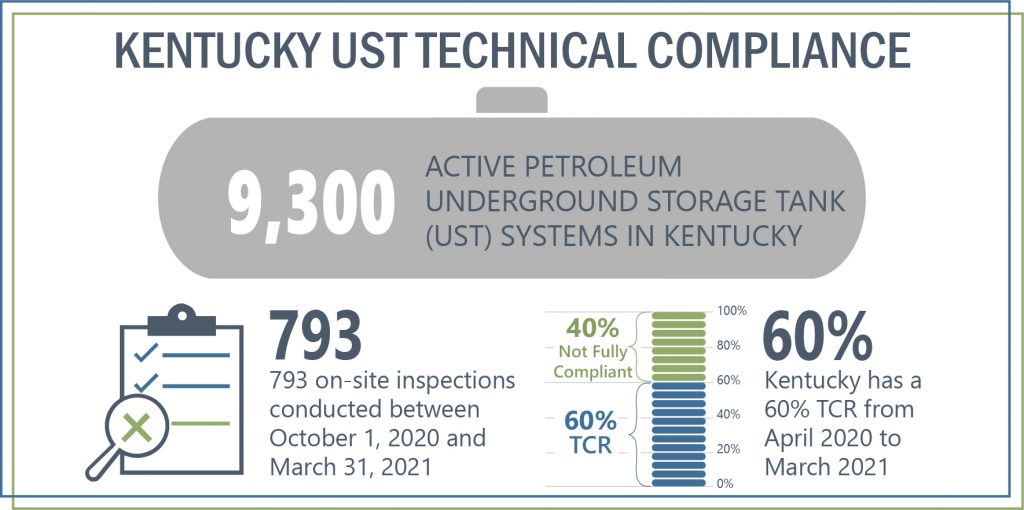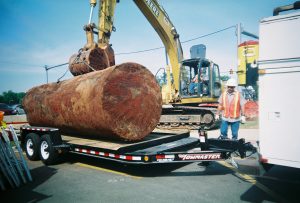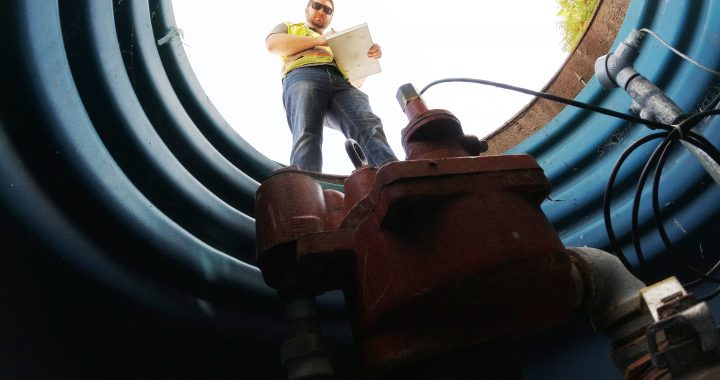There are over half a million active underground storage tanks (USTs) currently regulated by the EPA’s UST program (as of March 2021), with a technical compliance rate (TCR) of 59.3% between April 2020 and March 2021. That means just over 40% of UST systems were out of compliance in one or more of the four TCR categories outlined in the 2015 EPA UST regulations:
- spill prevention
- overfill prevention
- corrosion protection
- release detection
 In Kentucky, which has approximately 9,300 active petroleum USTs, 793 on-site inspections were conducted between October 2020 and March 2021, resulting in a TCR of 60%. That’s on par with the national numbers and better than the four other states reporting TCR for EPA Region 4, but it still means that 40% of UST facilities operating in the Commonwealth were out of compliance in one or more of the four TCR categories listed above – even though October 2018 was the federal compliance deadline. That’s a cause for concern for Kentucky facilities with active USTs.
In Kentucky, which has approximately 9,300 active petroleum USTs, 793 on-site inspections were conducted between October 2020 and March 2021, resulting in a TCR of 60%. That’s on par with the national numbers and better than the four other states reporting TCR for EPA Region 4, but it still means that 40% of UST facilities operating in the Commonwealth were out of compliance in one or more of the four TCR categories listed above – even though October 2018 was the federal compliance deadline. That’s a cause for concern for Kentucky facilities with active USTs.

UST Removal
What challenges do UST operators face in improving operational compliance for their facilities and raising Kentucky’s TCR? Aside from the obvious answers like having limited resources, time, and staffing, one hurdle is in understanding exactly what regulatory requirements apply to a given UST system. For example, one of the big changes to the 2015 federal UST regulations, which were incorporated into the 2019 Kentucky UST regulatory update, is that emergency generator UST systems are now required to meet the release detection requirements. These systems had been exempt from EPA release detection requirements since 1988, reflecting a big change for a variety of entities including hospitals, schools, and industrial facilities.

Ric Federico of EnSafe accepting, on behalf of Jr. Food Stores, Inc., the 2019 Outstanding Tank System Award from KPMA and Kentucky Underground Storage Tank Branch
Fortunately, for UST operators who may be struggling to meet the requirements, EnSafe has decades of experience navigating petroleum UST compliance to help our clients minimize impacts to the environment and their company’s bottom line. We have a proven track record building operational compliance programs from the ground up and then managing them to obtain award-winning results. No hyperbole there: our UST compliance clients have literally won the KPMA Outstanding Tank System Award administered by the Kentucky Department for Environmental Protection (KDEP) – UST Branch.
Not only is being out of compliance a regulatory liability, but it also puts UST systems at risk of releases that can wreak havoc on the environment. If you have a UST system release, EnSafe has you covered with our extensive experience managing release responses, site investigations, and corrective actions at petroleum release sites, as well as close working relationships with regulatory personnel at the regional and state level, including with the KDEP Environmental Response Team.

EnSafe’s Adam Wanta performing a UST compliance inspection.
EnSafe has trusted advisors that you can count on to help you achieve and maintain compliance. We are passionate about what we do and it shows in our work. If you are feeling overwhelmed by the 2015 UST regulations – and what often seems like a rocky path to compliance — we’d love to hear from you.
Contact Ric Federico, PG or Adam Wanta, PG today.
